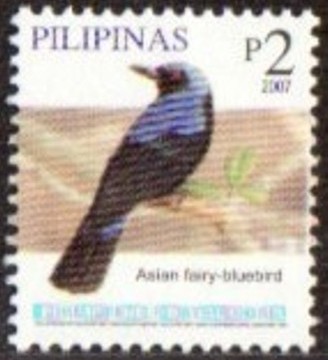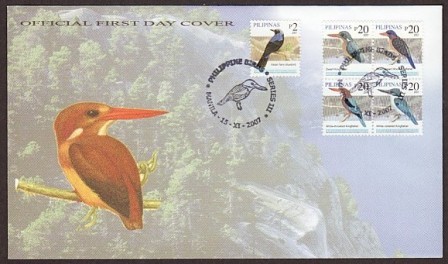2007, November 15. Philippine Birds Definitive Issue
Litho Offset. Amstar Company, Inc. Perf. 13 1/2
Singles, Sheets of 100 (10 x 10) (2p); Se-tenant Blocks of 4, Sheets of 100 (10 x 10) (20p)

2p Asian Fairy Bluebird - Singles (2,000,000)
2p Reprint marked "2008" (May 6, 2008) (500,000)
2p Reprint marked "2008A" (September 4, 2008) (500,000)
2p Reprint marked "2008B" (October 10, 2008) First order 500,000, Second order 500,000 - total of 1,000,000)
Se-tenant Blocks of 4 (1,187,500)
20p Dwarf-Kingfisher
20p Blue-capped Wood Kingfisher
20p White-throated Kingfisher
20p White-collared Kingfisher
Designer and Graphic Artist: Corazon T. Loza
Design Coordinator: Dr. Ngo Tiong Tak
Layout Artist: Robinson C. Cruza
Designs: All pictures taken from the book "A Guide to the Birds of the Philippines" by Robert S. Kennedy, Pedro C. Gonzales, Edward C. Dickinson, Hector C. Miranda, Jr., and Timothy H. Fisher.
First Day Covers: Manila
PHILIPPINE BIRDS
Asian Fairy Bluebird (Irena puella). Common and conspicuous in forest canopy in lowlands and middle elevations, singly or in small groups. The male has a unique brilliant blue and velvety black plumage. This bird calls a loud series of snapping whistles wavering whip whip whip-aaww or weeep weeep weee paw.
Dwarf-Kingfisher (Ceyx lepidus). Uncommon in low understory of lowland forest, singly or in pairs, not usually associated with water. Very fast darting almost invisibly from perch to perch. Color above varies from bright cobalt blue to aqua blue. All blue upperparts and rufous yellow underparts separate it from Philippine Dwarf-Kingfisher. They call high-pitched metallic pe-teeeet pe-teeeet while perched.
Blue-capped Wood Kingfisher (Actenoides hombroni). Uncommon, poorly known and hard to see from lowland to montane mossy forest up to 2000 m. They perch in dark recesses in the understory. They are generally quiet, except in dawn chorus when they give loud kiaw or te-u.
White-throated Kingfisher (Halcyon smyrnensis). Fairly common in clearings along large streams and rivers and in open country, in the lowlands below 1000 m. Perches 5 to 10m above ground or river on branches, even on telephone wires. Diagnostic dark chestnut body with bright blue wings, back and tail. Note white in wing when flying. They call descending whistle pe-pe-pe-pe-pe-pe lasting one second.
White-collared Kingsfisher (Halcyon chloris). The most common and conspicuous of all Philippine kingfishers, from exposed coral flats to towns and perched on telephone wires and on open country, rarely in forest. Turqouise blue upper parts with white collar and underparts diagnostic. They call loud harsh ke kak kak kak kak lasting 1.3 seconds repeated every 6 seconds, plus ke kek-kak and variations.
-
Birds

